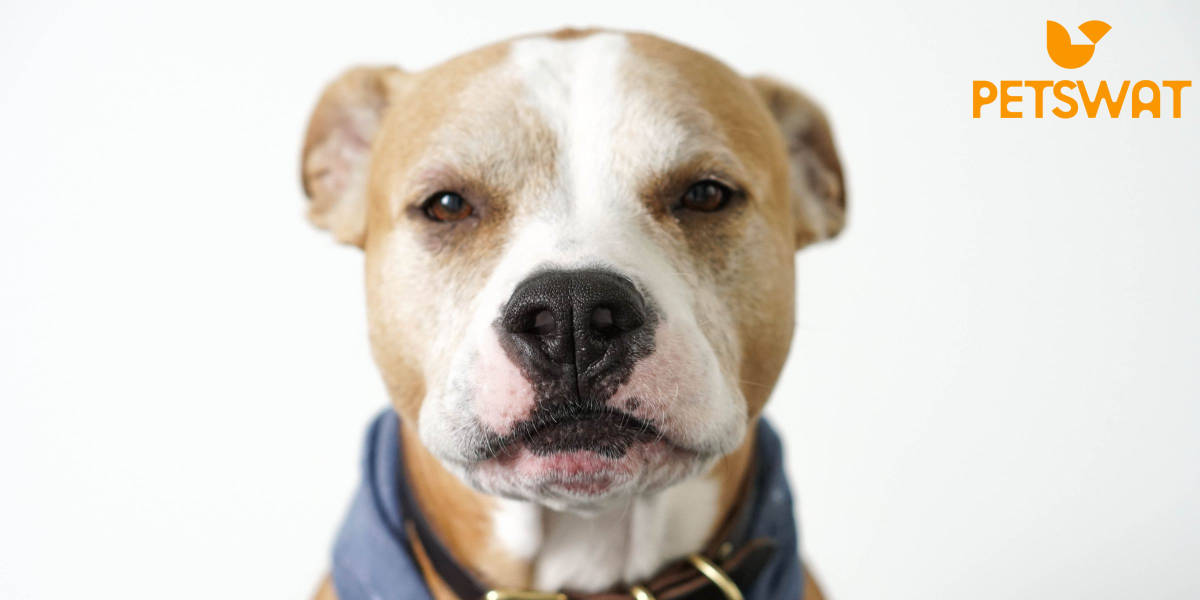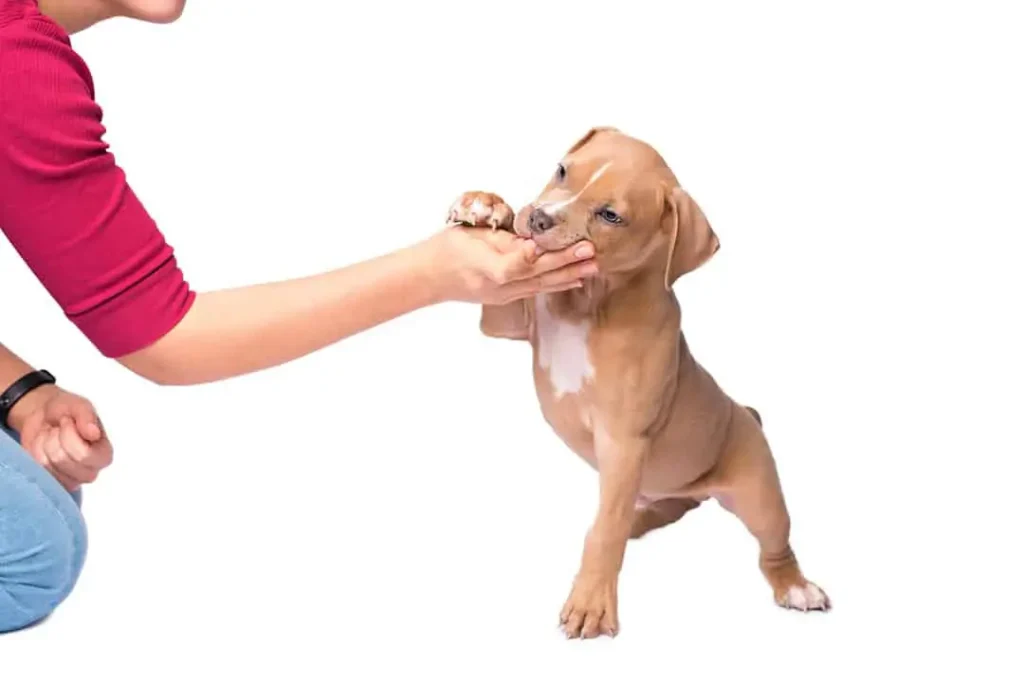Bite inhibition training is an essential aspect of raising a well-behaved pitbull puppy. Pitbulls are known for their strong jaws and potential for aggression, so it is crucial to teach them how to control their bite from a young age. In this post, let’s learn how to train a pitbull puppy not to bite.
By understanding the concept of bite inhibition and implementing positive reinforcement training techniques, you can ensure that your pitbull puppy grows up to be a well-mannered and safe companion.
Understanding Bite Inhibition in Pitbull Puppies
Bite inhibition refers to a dog’s ability to control the force of its bite. It is an important skill for all dogs to learn, but it is especially crucial for pitbull puppies due to their natural strength and potential for aggression. When a puppy is playing or interacting with others, it may use its mouth to explore and communicate. However, if the puppy has not learned bite inhibition, it may unintentionally cause harm with its bite.
Teaching bite inhibition involves teaching the puppy to control the force of its bite and to be gentle when interacting with humans or other animals. This is done through positive reinforcement training techniques, which reward the puppy for exhibiting appropriate behavior. By teaching bite inhibition, you can prevent your pitbull puppy from causing harm when playing or interacting with others.
The Importance of Teaching Bite Inhibition Early On
The critical period for socialization and training in puppies occurs between 3 and 14 weeks of age. During this time, puppies are most receptive to learning and are more likely to retain the lessons they are taught. This is why it is crucial to start teaching bite inhibition early on in your pitbull puppy’s life.
By teaching bite inhibition during this critical period, you can prevent future behavior problems. If a pitbull puppy does not learn how to control its bite, it may grow up to be an adult dog that bites too hard during play or becomes aggressive towards humans or other animals. By starting early and consistently reinforcing appropriate behavior, you can set your pitbull puppy up for success and prevent future issues.
Setting Realistic Expectations for Your Pitbull Puppy
It is important to understand the natural tendencies of the pitbull breed when setting expectations for bite inhibition training. Pitbulls are known for their strong jaws and tenacity, so it may take more time and effort to teach them bite inhibition compared to other breeds. However, with patience and consistency, it is possible to train a pitbull puppy to have a soft mouth and gentle bite.
When setting goals for bite inhibition training, it is important to be realistic. Every puppy is different, and some may learn faster than others. It is essential to focus on progress rather than perfection. Celebrate small victories along the way and remember that training takes time and patience. With consistent effort, your pitbull puppy will learn bite inhibition and become a well-behaved companion.
Positive Reinforcement Training Techniques for Bite Inhibition
Positive reinforcement training techniques are highly effective for teaching bite inhibition to pitbull puppies. These techniques involve rewarding the puppy for exhibiting appropriate behavior, such as having a soft mouth or gentle bite. By using positive reinforcement, you can encourage your pitbull puppy to continue exhibiting the desired behavior.
One example of a positive reinforcement technique is using treats or praise to reward your puppy when it exhibits a soft mouth or gentle bite. Whenever your puppy interacts with you or other animals without biting too hard, immediately reward it with a treat or verbal praise. This will reinforce the desired behavior and encourage your puppy to continue behaving appropriately.
Another positive reinforcement technique is redirecting your puppy’s biting behavior onto appropriate chew toys. Whenever your puppy starts to bite too hard during play or interaction, redirect its attention onto a chew toy. This teaches the puppy that biting on appropriate objects is acceptable while biting on humans or other animals is not.
Consistency is Key: Establishing a Routine for Training
Consistency is crucial when it comes to bite inhibition training. It is important to establish a routine and stick to it. This means consistently reinforcing appropriate behavior and redirecting inappropriate behavior. By being consistent, your pitbull puppy will learn what is expected of it and will be more likely to exhibit the desired behavior.
To establish a training routine, set aside dedicated time each day for training sessions. Keep the sessions short and focused, as puppies have short attention spans. Be consistent with your commands and rewards, using the same cues and rewards each time. By establishing a routine, you can create a structured environment for your pitbull puppy to learn and thrive.
Socialization with Other Dogs and People
Socialization is an essential aspect of raising a well-behaved pitbull puppy. It is important to expose your puppy to a variety of people, animals, and environments from a young age. This will help your puppy develop positive associations with different stimuli and learn how to interact appropriately with others.
When socializing your pitbull puppy with other dogs and people, start with controlled environments and gradually increase the level of exposure. Allow your puppy to interact with friendly, well-behaved dogs and people who can provide positive experiences. Always supervise interactions and intervene if necessary to prevent any negative experiences.
Avoiding Rough Play and Aggressive Behavior
It is important to avoid rough play and aggressive behavior when interacting with your pitbull puppy. Rough play can escalate quickly and may lead to aggressive behavior in the future. Instead, focus on gentle play and positive interactions that reinforce appropriate behavior.
If your pitbull puppy starts to exhibit rough play or aggressive behavior, immediately redirect its attention onto an appropriate activity or toy. This teaches the puppy that rough play is not acceptable and encourages it to engage in more appropriate behavior.
Recognizing Signs of Overstimulation or Aggression
It is important to be able to recognize the signs that your pitbull puppy is becoming overstimulated or aggressive. These signs may include growling, snapping, lunging, or stiffening of the body. If you notice any of these signs, it is important to respond appropriately to prevent any escalation.
If your puppy starts to exhibit signs of overstimulation or aggression, immediately remove it from the situation and provide a calm and quiet environment. Avoid punishing or scolding your puppy, as this may escalate the situation further. Instead, focus on redirecting its attention onto a more appropriate activity or toy.
Seeking Professional Help for More Challenging Cases
In some cases, bite inhibition training may be more challenging, especially if your pitbull puppy exhibits persistent aggressive behavior. If you are struggling to make progress with training or if your puppy’s behavior is becoming increasingly concerning, it may be necessary to seek professional help.
There are various professionals who can assist with behavior problems in dogs, including certified dog trainers and animal behaviorists. These professionals have the knowledge and experience to assess your pitbull puppy’s behavior and provide guidance on how to address any issues. Seeking professional help can be beneficial in ensuring the safety and well-being of both your puppy and those around it.
Celebrating Progress and Building a Strong Relationship with Your Pitbull Puppy
It is important to celebrate progress and build a strong relationship with your pitbull puppy throughout the bite inhibition training process. Celebrate small victories along the way, such as when your puppy exhibits a soft mouth or gentle bite. This positive reinforcement will encourage your puppy to continue exhibiting the desired behavior.
Building a strong relationship with your pitbull puppy is also crucial for successful training. Spend quality time with your puppy, engaging in activities that promote bonding and trust. This will create a strong foundation for training and ensure that your pitbull puppy sees you as a trusted and respected leader.
Conclusion
Bite inhibition training is an essential aspect of raising a well-behaved pitbull puppy. By understanding the concept of bite inhibition and implementing positive reinforcement training techniques, you can ensure that your pitbull puppy grows up to be a well-mannered and safe companion. Remember to start early, be consistent, and celebrate progress along the way. With patience and dedication, you can raise a pitbull puppy that is gentle and well-behaved.
Originally posted 2023-09-08 08:02:51.
Johny is a dedicated pet enthusiast, author, and the driving force behind the insightful content at PetSWAT. With a deep passion for animals and a wealth of knowledge acquired through years of experience, Johny brings a unique perspective to the world of pet care and companionship.



